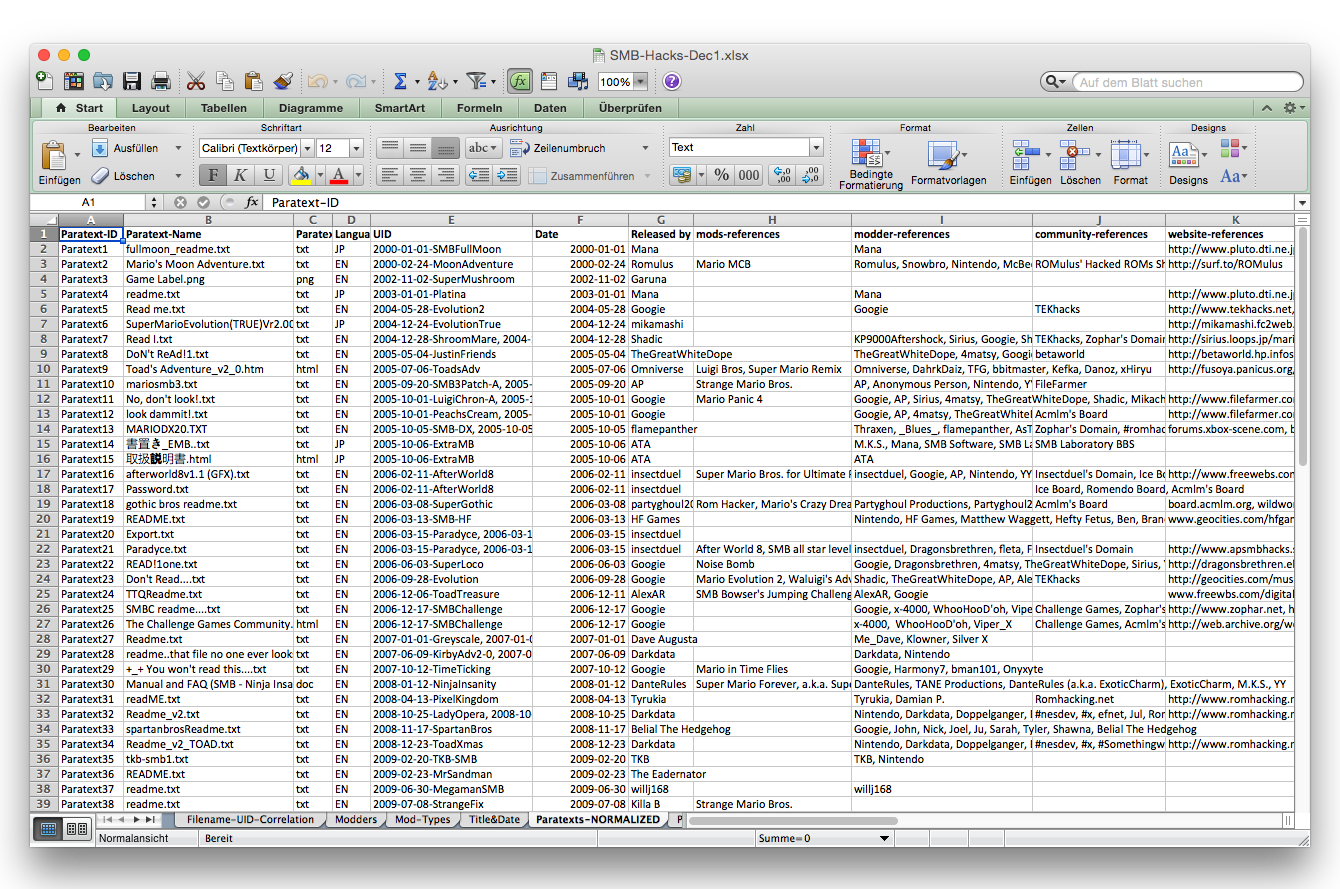
Correlating Code & Community (part 3)
The first step in my attempt to combine DH and CCS approaches was to mine data from the ROMhacking website and paratexts distributed with the patches and to create a spreadsheet with relevant metadata. (All of this data is also included in the Tools rubric of this webtext.) On this basis, I began to analyze and visualize the data with the visualization software Tableau. But while this yielded some basic information that might be relevant for assessing the serial community (e.g., the number of mods produced each year, including upward and downward trends; a list of the top modders in the community; and a look at trends in the types of mods/hacks being produced), the visualizations themselves were not very interesting or informative on their own.
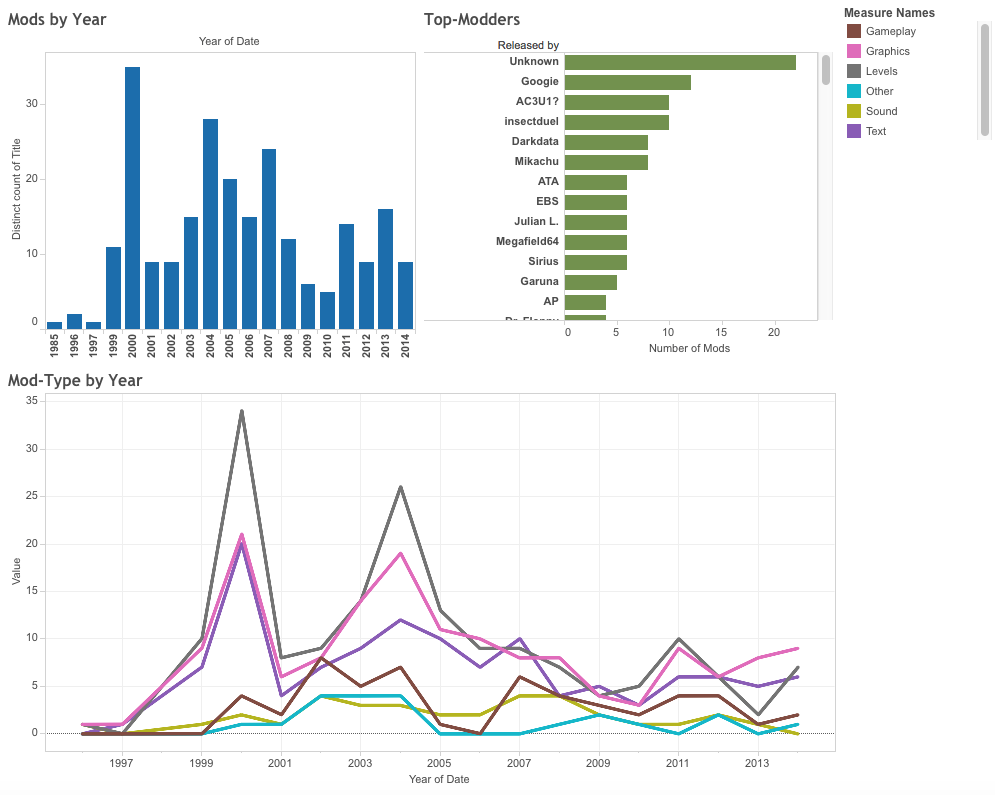
How could this high-level metadata be coordinated with and brought to bear on the code-level serialization processes that we saw in the hexcode? In looking for an answer, it became clear that I would have to find a way to collect some data about the code itself. The mods, themselves basically just diff files (i.e., files containing a record of the differences that are to be instantiated with respect to the original ROM file that is to be patched and modded), could be opened and compared with the diff function that powers some forms of DH-based textual analysis (e.g., text comparisons conducted with a piece of software like juxta). But the hexadecimal code that we can access here—and the sheer amount of it in each modded game, which consists of over 42,000 bytes—is not particularly conducive to analysis with such tools. In their current form, these tools do not support comparison of binary files, as they are geared towards comparison of human-readable text formats; as a consequence of this quasi-hermeneutic orientation, they are designed to deal best with differences at the level of words, sentences, and paragraphs, whereas the differences at stake in the masses of machine-readable hexcode are arguably more akin to typographical variations of typeface, point size, and kerning. Thus, the finer granularity and greater scope of code-level differences quickly strains text-oriented tools and pushes them beyond the limits of their designed purposes. It is therefore necessary to turn to code-oriented tools.

Many existing hex editors also include a diff analysis, but to facilitate a greater degree of usability and hence to enable more efficient research methods it would be desirable to have a graphical display of differences between the files in order to see the changes at a glance. Hexcompare, a Linux-based visual diff program for quickly visualizing the differences between two binary programs (as seen in the images to the right), provides a model for this type of comparison. In the left-hand window, the large block at the top provides a quick global representation of code-level differences between two binary files; the field of blue represents the areas in which the two files are identical, while the red blocks indicate differences between them. Users are able to click on these blocks to jump to the relevant byte-level differences (bottom left window), and from there switch over to a more detailed hex editor view (right-hand window) that allows the user to drill down into the code. However, the comparison thus enabled is restricted by limitations of the software: It is available only for local use on a Linux machine (no online or cross-platform compatibility), and it only considers two files at a time. If this type of analysis is to be of use for seriality studies, which deals with larger sets and sequences of repetition and variation, it will have to assess a much larger set of files or automate the comparison process.
To overcome these limitations, it was necessary to rethink the ways that the underlying code of the game mods is assessed, structured as data, and made available for visualization. The alternative approach outlined here was developed in conjunction with colleagues from Duke University's Visualization & Interactive Services. In particular, Eric Monson wrote a script in Python that analyzes the mod patch files and records the basic diff information they contain: the address or offset at which they instruct the computer to modify the game file, as well as the number of bytes that they instruct it to write. With this information, a much more useful and interactive visualization can be created with Tableau.
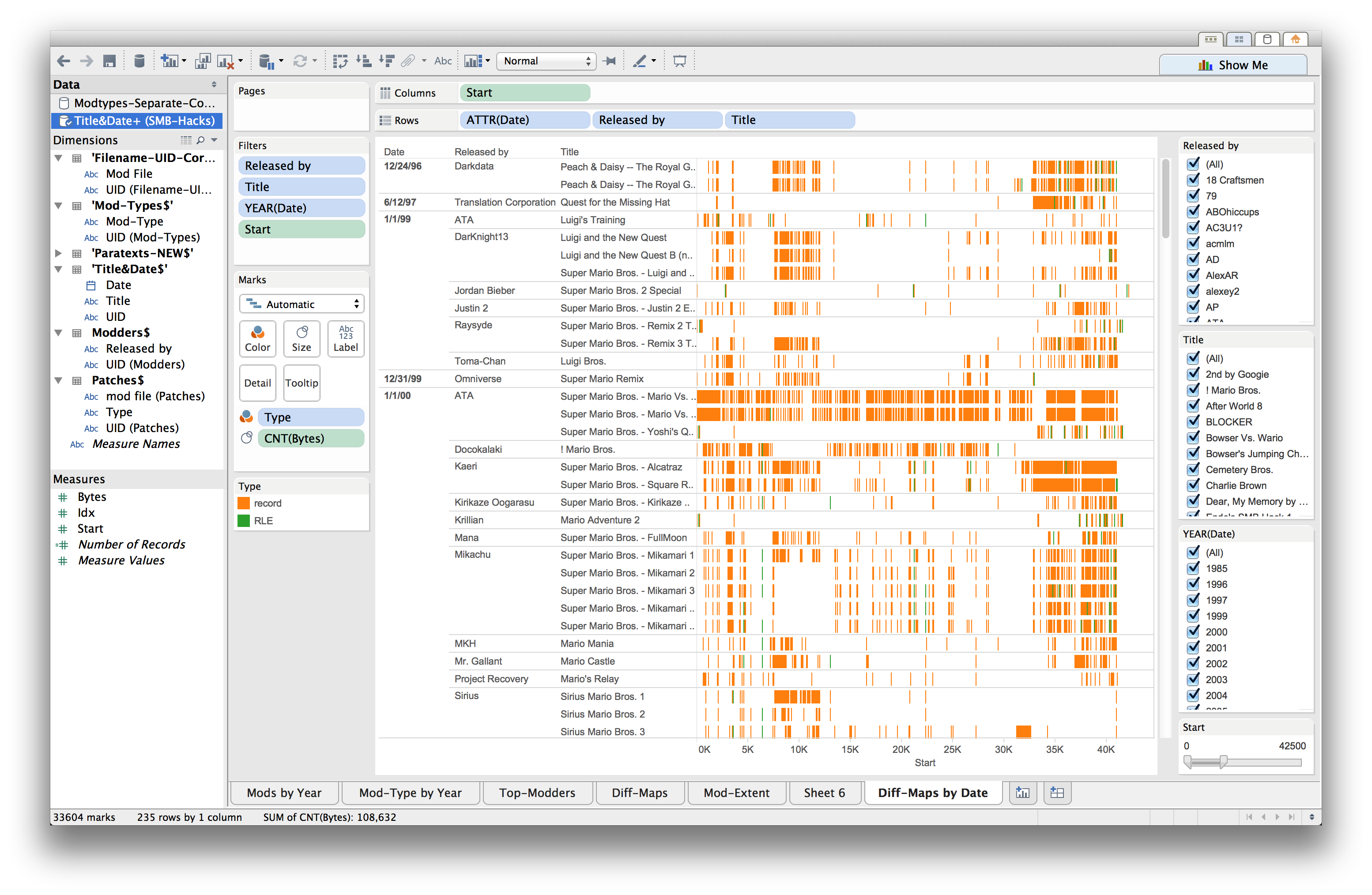
The resulting visualization uses Gantt charts, following a suggestion from Angela Zoss, to represent the size and location of changes that a given mod makes to the original Mario game; thus, it becomes possible to see a large number of these mods at a single glance, to filter them by year, modder, title, or even size, and in this way we can begin to see patterns emerging. (These interactive visualizations are included in the Tools section of this webtext.) In this way, a sort of distant reading is brought to bear on the level of code, combining DH and CCS in a way that renders serialization processes visible over a large set of code-level data. To understand the specific contribution of DH-type visualization here, contrast this approach with Mark Marino's (2006) call to "make the code the text," which despite his broad understanding of code and acknowledgement that software/hardware and text/paratext distinctions are non-absolute, was still basically geared towards a conception of CCS that encouraged critical engagements of the close reading type. As I have argued, however, researching seriality in particular requires that we oscillate between big-picture and micro-level analyses, between distant readings of larger trends and developments and detailed comparisons between individual elements or episodes in the serial chain.
However, it is still necessary to correlate this code-based data with the social level of online modding communities. For this purpose, it is useful to employ network graphing software, for example Palladio (a tool explicitly designed for DH work by the Humanities + Design lab at Stanford University), which I used to graph networks of actors and intertextual relations on the basis of metadata contained in Readme.txt and other paratextual files accompanying the mod patches distributed on ROMhacking.net. Here, for example, I have mapped the references (or "shout-outs") that modders made to one another in these paratexts, thus revealing a picture of digital seriality as a kind of "imagined community" (Anderson, 1991) of modders.
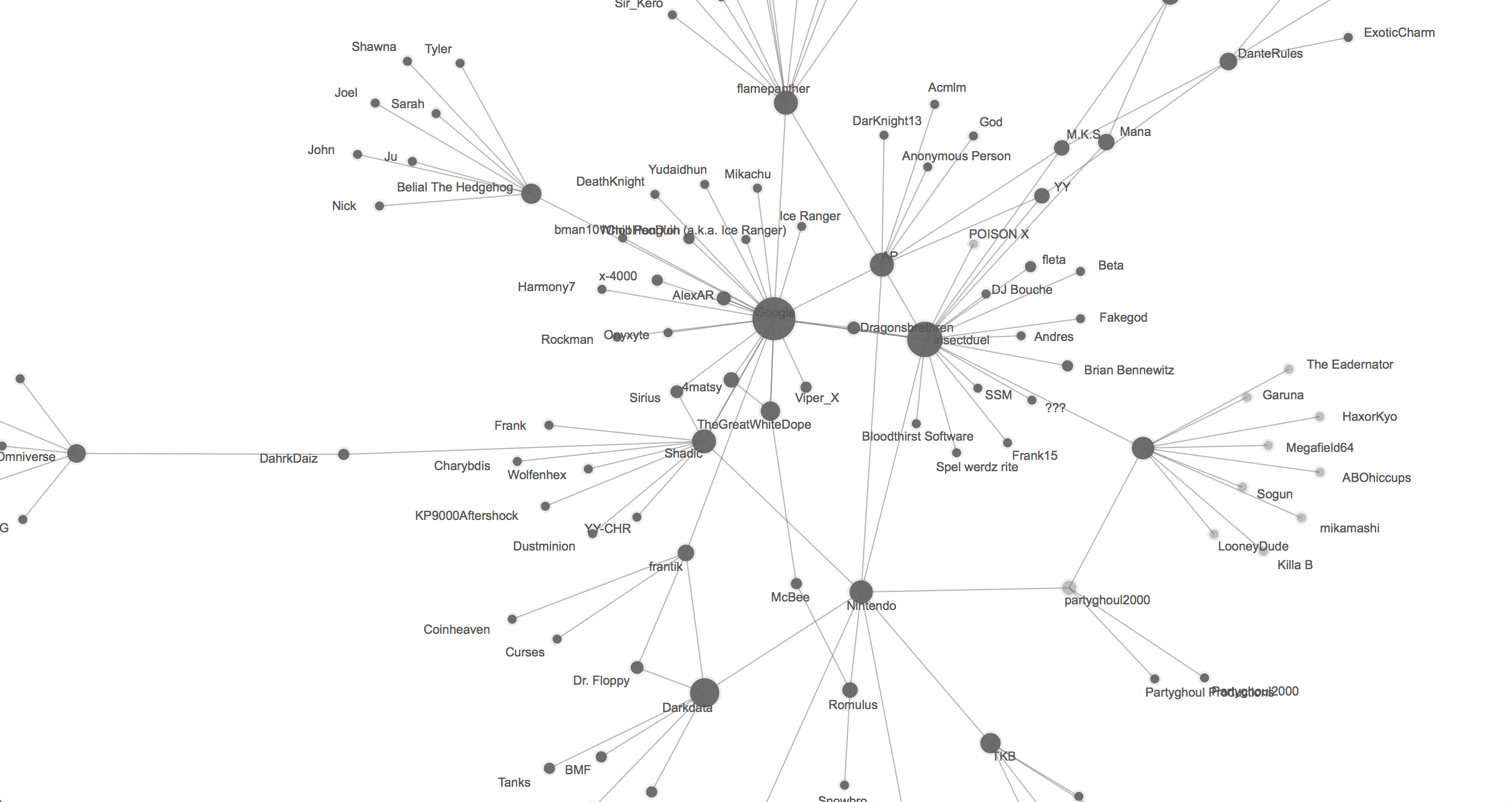
Below, on the other hand, I have mapped paratextual references to various online communities that have come and gone over the years. We see early references to the now defunct TEKhacks website, by way of other modding websites and message boards including Zophar's Domain, Acmlm, and Insectduel, with more recent references to Romhacking.net, which is the most recent community site and the one that I am studying here.
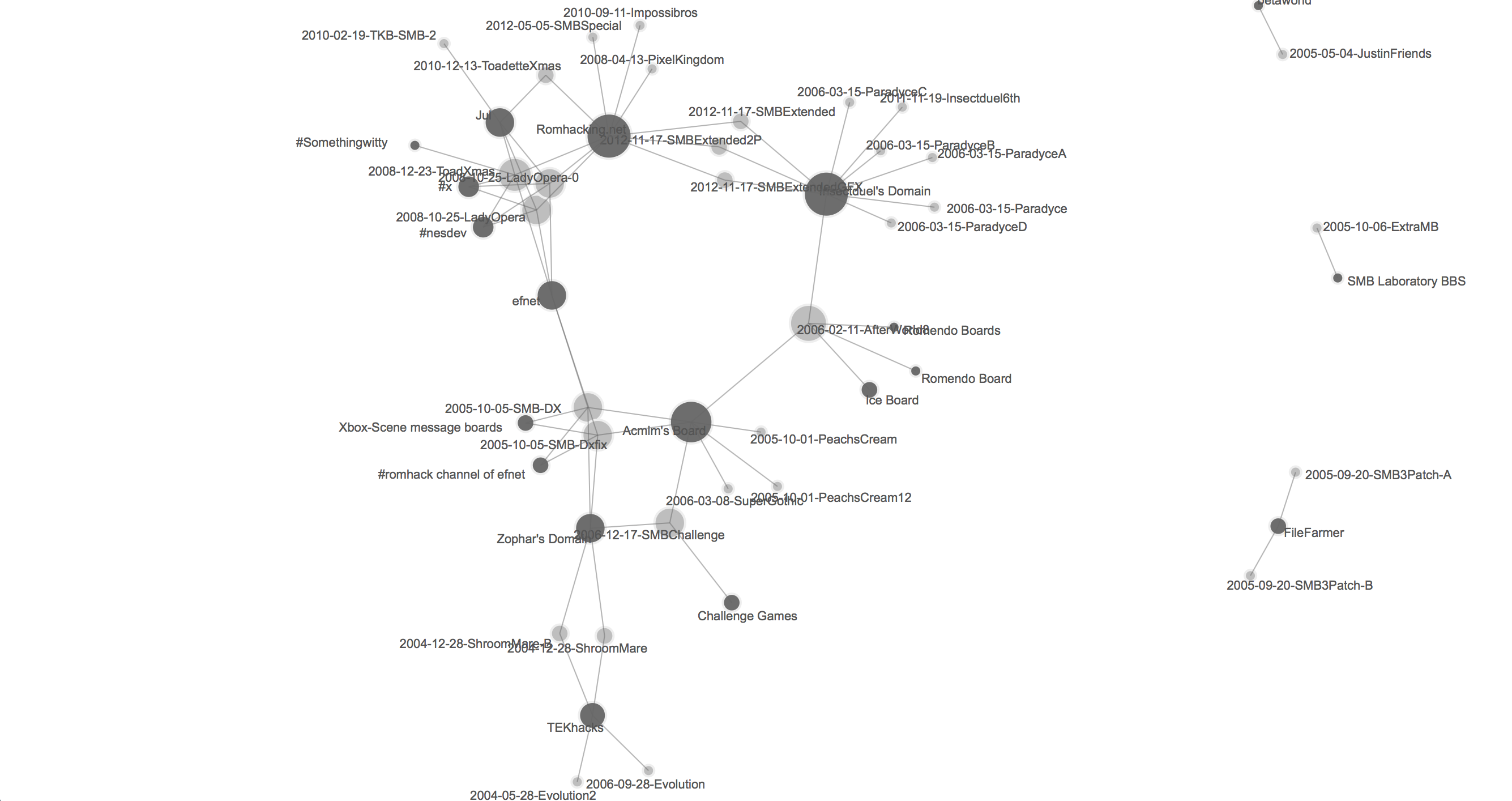
Such visualizations, because they are subject to various configurations and filterings of relevant parameters, offer a useful instrument with which to begin mapping the community formations that emerge and morph over time, both within and across the community forums that are designed to serve them. Together with the code-level visualizations discussed above, network graphs are thus an indispensable tool in the effort to trace serialization processes across the various levels of digital games and gaming communities.
(Note that one of the limitations of Palladio is that it is not possible to save and embed these visualizations for online interactive use. Thus, in the Tools section, readers will find a variety of community network graphs rendered in Cytoscape, an open-source network visualization program that does not have these limitations, and that can output its graphs as interactive webpages. Beyond this it remains possible, however, for interested readers to copy the underlying data, also included in the Tools section, and to use Palladio for local browser-based filtering and analysis.)